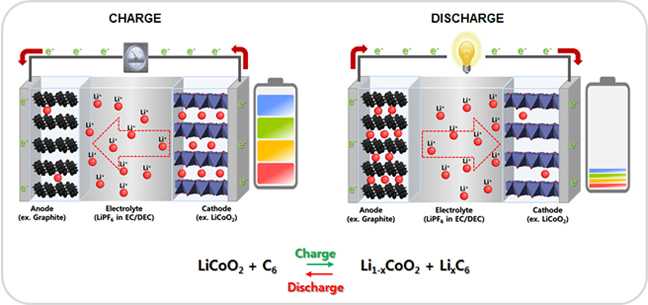Lithium (Li)-ion battery -
- Li-ion battery
-
Lithium-ion battery is a type of rechargeable battery in which a lithium ion moves between the anode and cathode. The lithium ions move from a lithiated graphite (LixC6) structure to a delithiated (Li1-xCoO2) structure during discharge and the reverse process occurs during charge. They are currently one of the most popular types of battery for portable electronics, with one of the best energy-to-weight ratios, no memory effect, and a slow loss of charge when not in use. In addition to uses for consumer electronics, lithium-ion batteries are growing in popularity for defense, automotive, and aerospace applications due to their high energy density. -
 -
- Characteristics
- High energy density
- High potential difference (3.5V ~ 4.2 V)
- Long cycle life
- Over 80% remaining capacity after 500 deep discharge cycles
- No memory effect like Ni-Cd
- Environmental friendliness
- Environmentally friendly materials
- No heavy metal like cadmium, mercury, etc.
-
- Electrode materials for Li-ion batteries
- Characterization of representative anodes
<caption class="dns">Characterization of representative anodes</caption> | Li metal | Graphite | Disordered carbon | Li-alloy | Li4Ti5O12 |
|---|
| Capacity | 3860 mAh g-1 | 372 mAh g-1 | ~250 mAh g-1 | >500 mAh g-1 | 170 mAh g-1 | | Potential | Low | Low | Low | Low | High | | Safety | Very poor | Poor | Good | Poor | Excellent | | Application | For next generation battery | Mobile IT | Power tool, HEV | Mobile IT, EV | Safe energy storage | - Characterization of representative cathodes
<caption class="dns">Characterization of representative cathodes</caption> | LiCoO2 | LiNiO2 | LiFePO4 | LiMnO2 | LiMn2O4 |
|---|
| Crystalline system | Layered | Layered | Olivine | Layered | Spinel | | Theoretical capacity | 274 mAh g-1 | 275 mAh g-1 | 170 mAh g-1 | 285 mAh g-1 | 148 mAh g-1 | | Specific capacity | ca. 145 mAh g-1 | ca. 160 mAh g-1 | ca. 150 mAh g-1 | ca. 190 mAh g-1 | ca. 120 mAh g-1 | Voltage
(V, Li/Li+) | 3.9 V | 3.7 V | 3.45 V | 2.8 V ~ 3.4 V | 4.0 V | |
|
|











